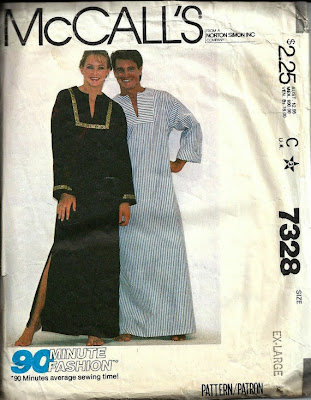
Apparently it's Questions Week here at MPB. (I don't plan these things, they just happen.)
Last month I received an email from reader Lynn S., suggesting an interesting blog topic. Here's what Lynn wrote:
I used to know a lot of women who sew and there was an almost universal attitude among them that "Men's clothes are too difficult." I can't honestly say that I will try anything but I decide for myself what's too difficult, so after I got married (over 35 years ago) I immediately started making shirts for my husband. I even made a couple of pairs of pants which didn't look at all professional.
I don't generalize. I think you can only judge the difficulty of patterns on an individual basis. But if one must generalize, it seems more logical to say that women's clothes are more difficult. Men's clothes usually don't have ruffles, gathers, princess seams, multi-tiered skirts or many other interesting details you commonly see on women's dresses. Pants can be difficult but women wear pants too. If we're talking about jeans, men's and women's have all the same elements.
Frankly, I think Lynn is hedging a bit here, don't you? I mean she's sort of saying women's clothing is more difficult, but then again the pants she made for her husband didn't come out so great. And women wear pants to.
Anyway, here's my response (a bit of a hedge too):
Thank you so much for your suggestion, Lynn. I think it's a great topic. I will say, however, that I once suggested (in an off-hand way) that sewing a men's suit wasn't as easy as whipping up a (women's) housecoat -- I've made both -- and someone accused me of sexism!
This is true.
So how do I answer Lynn's question? Do I think men's clothes are harder to make than women's? I hate to do this to you, friends, but I think the answer is, It depends.

Just as there are the three "b's" of music (Bach, Beethoven and Brahms), the three "r's" of schooling (reading, 'riting, and 'rithmatic), and the three Powells of MGM (William, Eleanor, and Jane -- what, were they running out of names?); I propose that there are also the three "f's" of sewing: fabric, fit, and finishing (I like to think I invented the "three 'f's'" so correct me if I'm wrong).
Let's consider the difficulty of sewing men's vs. women's clothes according to the three "f's."
FABRIC
Women's clothes are often made from more challenging fabrics than men's clothes are. You don't see too many silk chiffon men's shirts. Traditional menswear fabrics tend to be relatively easy to handle: not too shifty, not too loosely woven, not too many sequins. Therefore easier.
Men's clothing is more likely to be made from solid-colored fabric, however, and solids can be less forgiving of glitches, which can't be hidden by a busy pattern. So you have to be very careful with all those piddly details when you're sewing menswear. Therefore harder.
When you sew men's clothes, though, you're basically making the same three or four garments again and again and again: button down shirts, basic long trousers, notch lapel jackets, the occasional raincoat/overcoat, maybe boxers. There's nothing like the variation that exists for women's wear, so with practice you really can master the basics of a standard men's wardrobe. Easier.



FIT
The general consensus is that men's bodies are easier to fit (Kenneth King once told me so, so don't shoot the messenger). We don't have boobs (well, not the kind we want to have stand up and out anyway) and we generally have narrow hips and less shapely...everything. Exceptions exist, obviously, but I'm talking about what's most common. Easier.
Men rarely wear clothing that wraps (and is therefore instantly customizable) and elastic waistbands are a bit of a cop out. Clothes must fit. Harder.
FINISHING
I think we can consider tailoring under "finishing" though it also is related to fit.
By tailoring, I mean all those fancy pockets and layers of special interfacings and all that careful fitting; it's not always clear just how tailoring is defined, frankly. There's a lot of all this in most men's clothes and it's hard to do unless you have experience. Of course women wear tailored clothes too, but most casual women's clothing these days consists of stretch knits.
Men's clothes are also held to a higher professional standard. We're accustomed to a certain finish to a men's suit, for example: we don't see too many home-sewn suits out there and the difficulty of making them look professional is part of the reason. It's not that there are necessarily more details involved in making men's clothes, but rather that we are accustomed to seeing men's clothes look a certain way with little variation: i.e., the fly zipper goes here, the shirt pockets look like this, the collar is this wide/long, etc. Hence, harder.

I think rather than talk about men's vs. women's, we might talk about tailored vs. non-tailored clothing. All those finicky details, whether on men's clothes or women's clothes, are exacting. Same goes for precise fit and dealing with lots of itty bitty pattern pieces for things like inside breast pockets.
Readers, that's my take.
I'd be curious to know what you think. Have I missed anything?
Which is more difficult to sew: men's clothing or women's clothing? (If you've sewn both, I'd especially love to hear from you.)
Have a great day, everybody!

























































